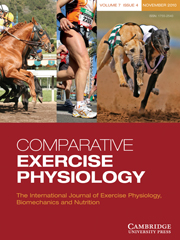Article contents
Growing more durable equine athletes
Published online by Cambridge University Press: 23 July 2010
Abstract
Discussions on growing more durable equine athletes often revolve around developmental orthopaedic disease (DOD). What degree of DOD, if any, is acceptable or inconsequential to long-term athletic performance remains a question. Much effort has been directed toward diminishing or eliminating the incidence and severity of DOD, but with limited success. We must continue to define what degree the management decisions affect the horse during different stages of its growth. It would seem logical that the most profound influence would occur during the most rapid periods of growth. Therefore, concerns have been directed toward the last third of gestation and the possible indirect effect that broodmare management has on foetal development. The early postnatal period is another period of rapid growth; thus, the effect of broodmare management on lactation may affect the growth of the foal. Management will also have a direct effect on growth and development from weaning through to maturity. Recent research in other species as well as in horse suggests that genetic predisposition is the primary determinant of DOD. Non-nutritional management also may have significant effects on articular and skeletal health and athletic durability. Much effort has been directed toward nutrition and potential impact on DOD, but with limited success. Except for overt deficiencies, or perhaps excessive imbalances, nutrition does not appear to be a primary determinant of DOD, particularly of focal lesions associated with osteochondrosis. However, nutrition may serve a secondary role in diminishing the severity and incidence of DOD in horses genetically predisposed to such conditions. Producing horses that will have long-term and productive athletic careers requires sound management that starts at conception and continues throughout the life of the horse.
Information
- Type
- Review Article
- Information
- Copyright
- Copyright © Cambridge University Press 2010
References
- 4
- Cited by

